Cycle News Staff | July 17, 2018
Last month, Yamaha took the covers off the 2019 Yamaha YZ250F revealing an all-new motorcycle—this month we get to ride it.
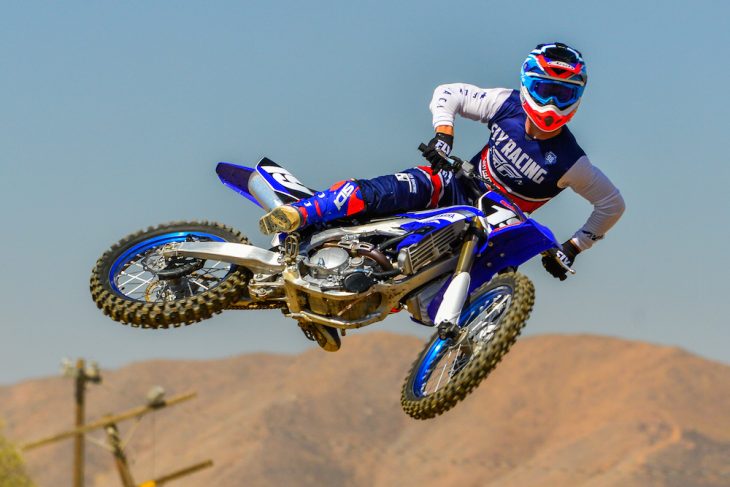 The 2019 Yamaha YZ250F might have gained a few points but it still feels light and nimble. Photography: Kit Palmer
The 2019 Yamaha YZ250F might have gained a few points but it still feels light and nimble. Photography: Kit Palmer
At first glance, the 2019 YZ250F might not look a whole lot different than the previous model, but look again—it is! It’s got a new frame, a new engine, updated suspension and improved bodywork. It now looks nearly identical to its bigger brother, the YZ450F, which got a major overhaul last year. Now it’s the 250’s turn.
In the big picture, Yamaha stayed true to its rearward-slanted cylinder, with its downdraft-style forward intake and rear exhaust, but changed just about everything else. They started with a new engine case to house the compact high-output electric starter and a new stator and rotor. By losing the manual kick start system, it actually freed up a little power that was normally sucked up by the charging system. Now, with the addition of the new lightweight lithium ion battery that’s been installed to run the electric starter, the engine no longer has to produce as much power from the stator, freeing up more power for the rear wheel. Hey, in the 250 class every little bit helps.
2019 Yamaha YZ250F Ride Review
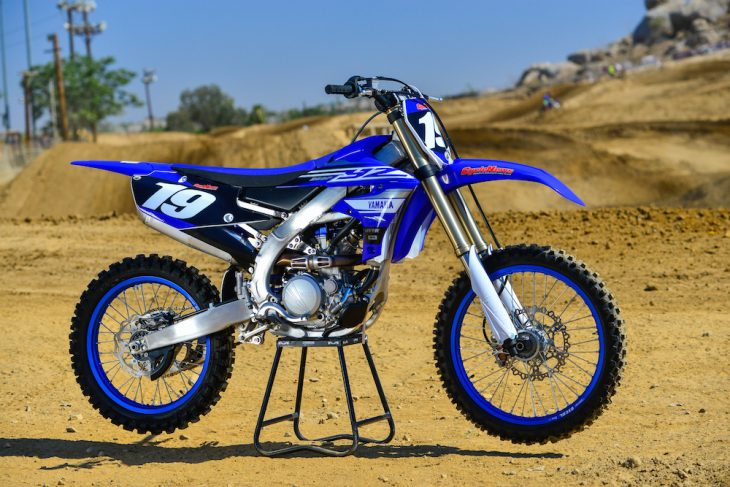 MSRP has increased $500 to $8199, but you still get a lot of motorcycle for the money.
MSRP has increased $500 to $8199, but you still get a lot of motorcycle for the money.
The center-mounted starter motor is direct-mounted to a new clutch basket. The whole clutch assembly has been beefed up as well for a softer clutch pull and better durability. Yamaha increased the clutch plate diameter, added an extra clutch spring (from five to six) and increased the steel cutch plate thickness. This allowed them to lose a clutch friction plate (from nine to eight). Now, the clutch action is both smoother and lighter than before due to the softer clutch spring pressure, yet it still grabs extremely strong with the extra spring for a wider spread of clamping force. You’ll notice the difference compared to your 2018 YZ250F.
Part of the Yamaha’s winning formula when it comes to the YZ250F has been its class-leading engine. In recently years, the YZ250F has never been accused of being slow, that is for sure. For 2019, Yamaha made a big effort to squeeze even more power out of the YZ250F’s engine, which has a new cylinder head, valve train, intake cam, and piston. Yamaha’s main target was to boost mid and top-end power, without sacrificing torque, some it already had lots of. The head has a straighter exhaust port outlet and the intake gets a smoother intake port shape along with a brand new two-step CNC machining process at the port and valve seat. This increases both flow and horsepower. The intake cam has more lift and the bike gets larger-diameter lifter buckets and stiffer valve springs to prevent valve float. It is topped off with a new piston with a higher compression of 13.8:1 (up from 13.5:1 from last year). All of Yamaha’s work paid off. This bike is faster! We noticed it right away.
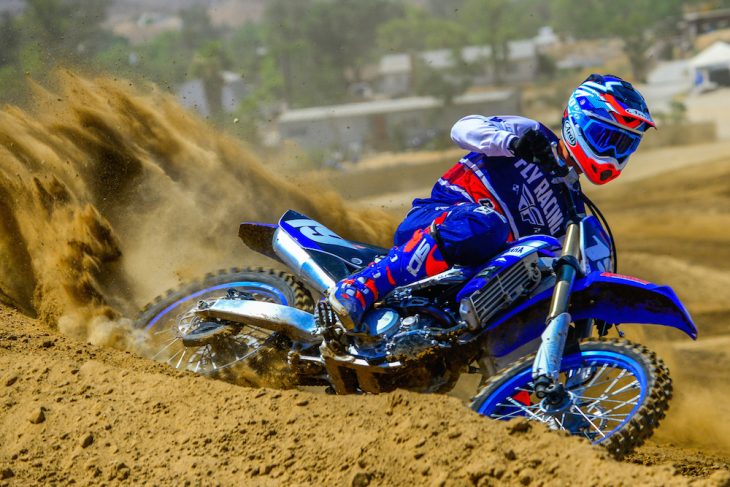 The first thing our testers said after riding the 2019 Yamaha YZ250F for the first time was that it turned much better than the older YZ.
The first thing our testers said after riding the 2019 Yamaha YZ250F for the first time was that it turned much better than the older YZ.
Riding the 2019 YZ250F back to back with the 2018 reveals big differences. Power-wise, they actually feel very similar down low, but as soon as you transition into the middle of the powerband, the 2019 starts to pull away from last year’s bike, and keeps doing so as you reach top end. Our test riders all agreed that the ’19 feels noticeably more powerful from midrange on up, and didn’t lose any torque that it’s famous for.
In response to the increase of power, Yamaha beefed up the transmission by using stronger materials where needed, so durability should be just as good as before.
In the chassis department, the ’19 YZ250F features a brand new bilateral beam aluminum frame, which is now identical to the 2019 YZ450F’s frame. The YZ has been criticized in previous years for being wider than some of the other bikes and for having a slight inconsistent feel over high-speed bumps. Engineers addressed these things by adding rigidity to the frame in key areas, like changing the backbone down tubes and moving the steering head tube forward 6mm. You can feel the results.
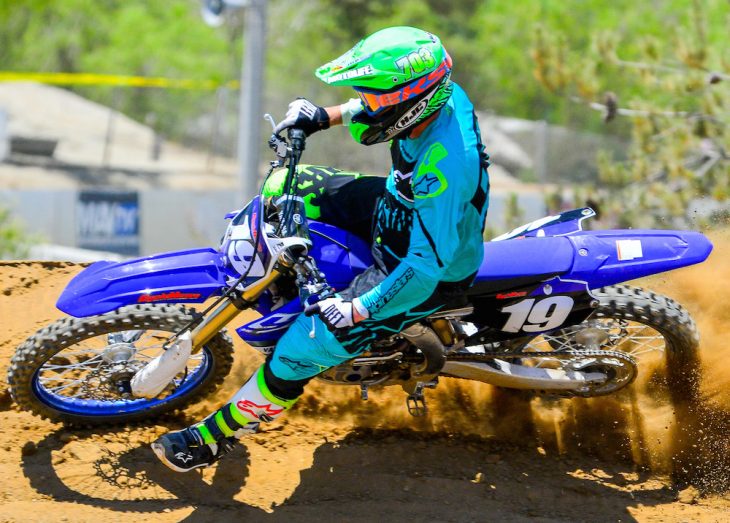 Yamaha made a big effort to make the YZ250F feel slimmer. And it does.
Yamaha made a big effort to make the YZ250F feel slimmer. And it does.
Our test riders could immediately feel the difference between the ’18 and the ’19—mainly in the turns. One of them said that the new YZ just plain corners better than the ’18. The ‘19 has a more precise feel in the turns and requires less effort on the rider’s part to lay the bike down in the ruts. And once its there, the Yamaha tends to stay there and track better than the ’18. Even in the berms, the new YZ has a more planted, precise and controllable feel.
Even though the new YZ gets in and out of the turns quicker now, no straight-line stability was sacrificed. At speed, the new YZ feels just as stable as before, and that was a major strongpoint with past YZs. So now the YZ is stable and it turns.
The seat foam was trimmed down in the rear to give the effect of a lower sub-frame and getting ride of any “stink bug” feeling when running sag at the recommended 100-105mm. Lots of changes went into making the bike feel thinner, as well. And they all worked.
The radiators were pushed forward at the bottom and tucked in tighter, and the gas tank and radiator shrouds were reduced in width directly at your knees. And the whole area around the rider’s knees has been cleaned up nicely; those plastic rivets are gone, replaced by a more one-piece shroud that really gives the bike a clean- and smooth-looking finish. The fuel tank is smaller, too. Capacity has been reduced from 2.0 gallons to 1.6 gallons. And it all feels better, too. Our test riders said that the YZ definitely feels thinner between your legs. The lack of fuel capacity hasn’t been an issue for us yet.
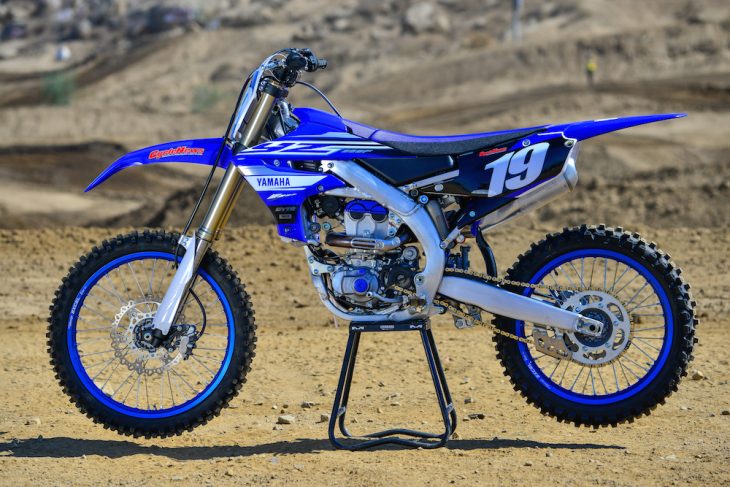 Electric starting might’ve added a few pounds but we’re not complaining.
Electric starting might’ve added a few pounds but we’re not complaining.
The 2019 YZ250F is slightly heavier than the ’18. Yamaha says it’s about three pounds heavier (231 pounds to 234 pounds, wet), but you will not feel it on the track. None of our test riders did.
One thing they did notice, however, was the new Bridgestone Battlecross tires that now come stock on the 250; these are different from the Dunlop MX3s found on the 2019 YZ450F. Our test riders felt that, on the 250, at least, the Bridgestones are, as how one tester put it, “way” better, saying they stick and track with more confidence in the turns, especially on hard-packed surfaces. “They don’t slide around as much,” said one tester.
The previous YZ already had one of the best suspension packages in the business with its KYB Speed Sensitive System coil-spring forks up front and KYB shock in the back, so Yamaha didn’t mess much with what was already a good thing; they did, however, go with slightly stiffer spring rates for ’19 and made some internal changes both front and back. These changes can be felt; they give the new YZ a slightly more “rigid” feel, while still retaining some plushness for the smaller bumps and providing a comfortable overall feel. The YZ’s suspension seems to cover a wide range of riders, in terms of weight and riding talent, without having to make drastic changes, like swapping out springs.
Some of my favorite new bits of the bike is how easy it is to access the air filter via the tool-less airbox, which make changing filters a breeze, and the new two-position handlebar map button switch, that gives you the ability to make adjustments pretty much on the fly.
And speaking of mapping, the ’19 YZ250F now works with Yamaha’s power-tuning app that made its debut on last year’s YZ450F. It’s fantastic. The app makes engine tuning extremely simple, and it does so much more, like logging dates, reading diagnostic codes, and keeping track of maintenance. You can easily swap maps with your friends, too. It’s a great device and fun to use. And it’s free!
So far, we’re pretty impressed with the 2019 Yamaha YZ250F. Without question, it took steps in the right direction with every change they made to it, though some people might not like the idea of the smaller-capacity fuel tank, the added three pounds, or the $500 that’s been tacked on to the price tag, but we feel the trade-offs are well worth it. CN
By Ricky Yorks
 The YZ250F gained more power on top, but it retains its already great bottom-end and torque.
The YZ250F gained more power on top, but it retains its already great bottom-end and torque.